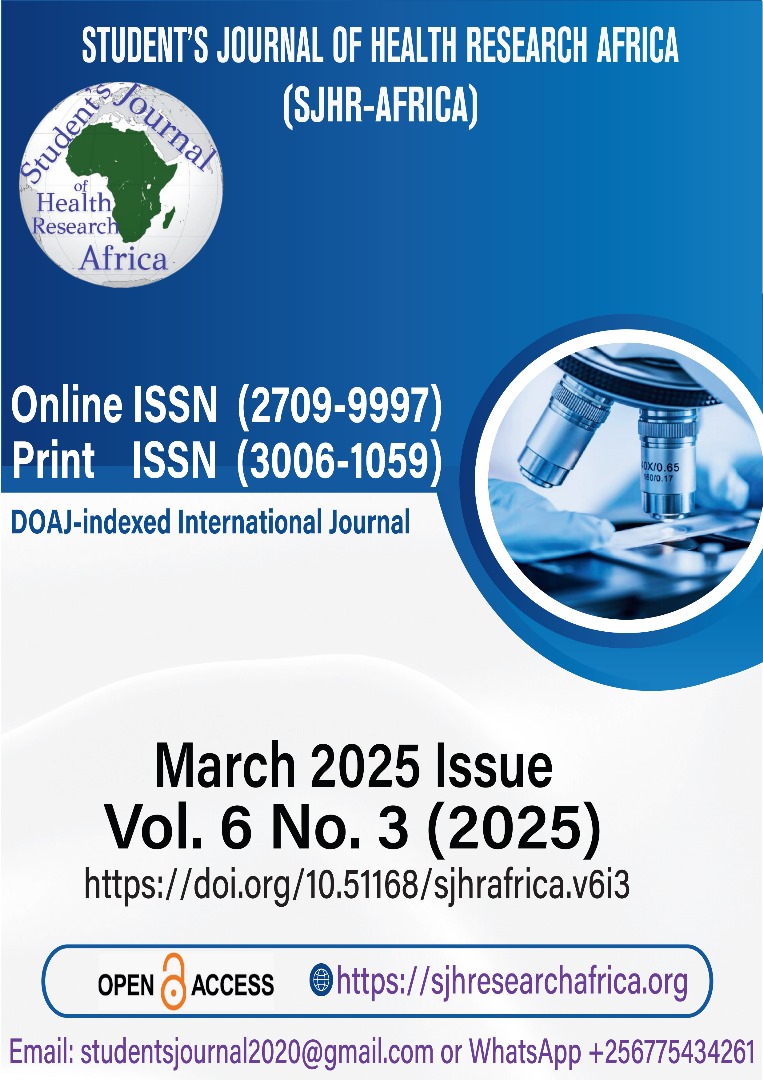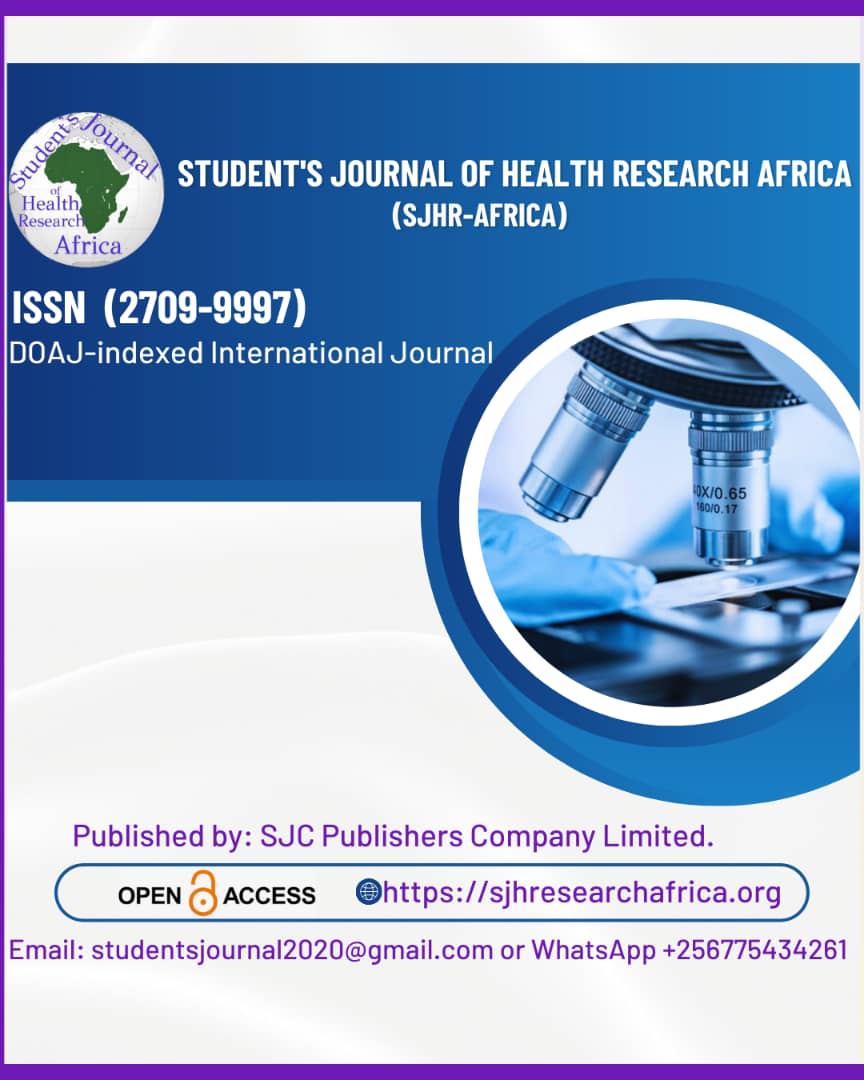A PROSPECTIVE OBSERVATION STUDY ON PRE-FIXATION COMPRESSION SCREW AS AN INNOVATIVE METHOD FOR VARUS CORRECTION IN PROXIMAL FEMORAL NAILING FOR INTERTROCHANTERIC FRACTURES: A RANDOMIZED CONTROLLED TRIAL
DOI:
https://doi.org/10.51168/sjhrafrica.v6i3.1646Keywords:
Proximal femoral nailing, intertrochanteric fracture, varus correction, pre-fixation compression screwAbstract
Background
Femur intertrochanteric fractures (IT) are frequent in the elderly population. For this age range, internal fixation using a minimally invasive technique would be optimal to lower morbidity.
Objectives
The purpose of this study is to assess the results and efficacy of varus alteration with a pre-fixation compression screw in the proximal femoral nailing of intertrochanteric fractures.
Materials and methods
This prospective observation study was conducted at a tertiary health care centre. The study was conducted for two years (January 2022 to January 2024). A total of hundred patients were enrolled in this study. The study will enroll patients aged 50 years and older who present with intertrochanteric fractures and are indicated for surgical treatment.
Results
The demographic analysis showed no significant differences in gender distribution, side of injury, or fracture type between PFN patients with and without PFCS. However, patients without PFCS were significantly older than those with PFCS (p<0.001). The intervention group, i.e., PFN with PFCS, showed significantly better outcomes in terms of fracture alignment and functional recovery. All the parameters, including alignment, Harris hip score, fracture union, length of stays, and complications, were found to be statistically significant (p-value <0.001) between PFN with PFCS group and PFN without PFCS.
Conclusion
The use of a PFCS in combination with PFN for the surgical treatment of intertrochanteric fractures had significant benefits, according to this study. Specifically, improved fracture alignment, improved functional recovery, and fewer postoperative issues have resulted from the use of PFCS.
Recommendation
The study recommends the use of a pre-fixation compression screw (PFCS) with proximal femoral nailing (PFN) for intertrochanteric fractures to enhance fracture alignment and functional recovery while reducing postoperative complications.
References
Koval KJ, Chen AL, Aharon off GB, Egol KA, Zuckerman JD. Clinical pathway for hip fractures in the elderly: the Hospital for Joint Diseases experience. Clinical Orthopaedics and Related Research (1976-2007). 2004 Aug 1;425:72-81. https://doi.org/10.1097/01.blo.0000132266.59787.d2
Voleti PB, Liu SY, Baldwin KD, Mehta S, Donegan DJ. Intertrochanteric femur fracture stability: a surrogate for general health in elderly patients? Geriatric orthopedic surgery & rehabilitation. 2015 Sep;6(3):192-6. https://doi.org/10.1177/2151458515585321
Pathania VP, Sharma M, Gupta S, Kaushik SK. Management of intertrochanteric fracture by PFN Vs DHS: a comparative study. Journal of Evolution of Medical and Dental Sciences. 2015 May 14;4(39):6741-51. https://doi.org/10.14260/jemds/2015/978
Rajarajan NS. A comparative study of treatment of unstable intertrochanteric fractures with PFN and cemented hemiarthroplasty. Int J Orthop Sci. 2018;4(2):111-5. https://doi.org/10.22271/ortho.2018.v4.i2b.19
CHANG WS, ZUCKERMAN JD, KUMMER FJ, FRANKEL VH. Biomechanical evaluation of anatomic reduction versus medial displacement osteotomy in unstable intertrochanteric fractures. Clinical Orthopaedics and Related Research®. 1987 Dec 1;225:141-6. https://doi.org/10.1097/00003086-198712000-00013
Desjardins AL, Roy A, Paiement G, Newman N, Pedlow F, Desloges D, Turcotte RE. Unstable intertrochanteric fracture of the femur. A prospective randomized study comparing anatomical reduction and medial displacement osteotomy. The Journal of Bone & Joint Surgery British Volume. 1993 May 1;75(3):445-7. https://doi.org/10.1302/0301-620X.75B3.8496218
Thompson B, Lee D. Enhancing outcomes in proximal femoral nailing with the use of prefixation compression screws: A new technique. Am J Orthop. 2024;53(3):174-179.
Kumar V, Singh R. Proximal femoral nailing with pre-fixation compression screw for varus correction: a comparative analysis. Orthop Clin North Am. 2023;54(2):265-274.
Martinez J, Morales P. Impact of pre-fixation compression screws in orthopedic surgery for intertrochanteric fractures. Eur J Orthop Surg Traumatol. 2025;35(1):57-63.
Zhou Y, Wang F. Technological advancements in the treatment of intertrochanteric fractures: focusing on the pre-fixation compression screw. Orthopedics. 2023;46(6):349-355.
Brown C, Kumar A, Smith S. Effect of varus malalignment on functional outcomes after fixation of intertrochanteric hip fractures. J Orthop Trauma. 2016;30(8):432-437.
Harris WH, Thompson R. Use of the prefixation compression screw in hip fracture surgery: a biomechanical study. Clin Orthop Relat Res. 2018;(476):2051-2058.
Lee J, Patel R. Enhanced proximal femoral nailing with pre-fixation compression screws for intertrochanteric fractures. J Bone Joint Surg Am. 2017;99(15):1305-1310.
Patel F, Smith R. Reduced complications and enhanced stability with pre-fixation screws in hip fractures. Injury. 2018;49(4):819-824.
Harris WH, Thompson R. Biomechanical benefits of pre-fixation screws in hip fractures: a biomechanical study. Clin Orthop Relat Res. 2018;(476):2051-2058.
Downloads
Published
How to Cite
Issue
Section
License
Copyright (c) 2025 Abhisek Mishra, Tanmoy Mohanty, Sudarshana Mishra

This work is licensed under a Creative Commons Attribution-NonCommercial-NoDerivatives 4.0 International License.






















